fujifilm DRYPIX 6000 User Manual

Fuji Medical Dry Laser Imager
(DRYPIX 6000)
Reference Guide
8th Edition : February 2017
For Safe Operation
Product Overview
Basic Operation
Utility
Troubleshooting
Care and
Maintenance
Appendix
Maintenance and
Inspection
This Manual describes details on how to operate the DRYPIX Smart and cautions to be observed when operating it. Please read this manual
thoroughly before actually operating the DRYPIX Smart After reading this manual, store it nearby the DRYPIX Smart so that you can see it whenever necessary.
897N102437G

ii DRYPIX Smart Reference Guide 897N102437G

Introduction
This manual provides detailed explanations of operation methods and cautions to promote proper understanding of functions and more effective usage.
Accompanying documents were originally drafted in the English language.
Installation may only be conducted by authorized service personal.
This manual is applicable to the following software.
• DRYPIX Smart Main Software V. 1.0 or later
Indications for use (for U.S.)
Fuji Medical Dry Laser Imager, model DRYPIX Smart (DRYPIX 6000) is indicated for use in providing diagnostic quality medical images on film for aid in physician diagnosis, including the printing of images and associated identification information from various digital imaging source modalities, including but not limited to,Computed Tomography (CT), Magnetic Resonance Imaging (MRI), Ultrasound,Computed Radiography, Digital Radiography, Digital Mammography and Nuclear Medicine.
Intended use (for European Union and other countries.)
Fuji Medical Dry Laser Imager DRYPIX Smart (DRYPIX 6000) is a device that prints digital image data transferred via the DICOM network from the FCR/FDR Image Reader or DR, CT, MRI and other imaging modalities onto the Fuji Medical Dry Laser Image Film.
Note : The above statements were determined by applicable medical device regulations which vary throughout the world. These statements are subject to revision when additional clearance or approval is obtained.
 CAUTIONS
CAUTIONS
1.No part or all of this manual may be reproduced in any form without prior permission.
2.The information contained in this manual may be subject to change without prior notice.
3.FUJIFILM Corporation shall not be liable for malfunctions and damages resulting from installation, relocation, remodeling, maintenance, and repair performed by other than dealers specified by FUJIFILM Corporation.
4.FUJIFILM Corporation shall not be liable for malfunctions and damages of FUJIFILM Corporation products due to products of other manufacturers not supplied by FUJIFILM Corporation.
5.FUJIFILM Corporation shall not be liable for malfunctions and damages resulting from remodeling, maintenance, and repair using repair parts other than those specified by
FUJIFILM Corporation.
6.FUJIFILM Corporation shall not be liable for malfunctions and damages resulting from negligence of precautions and operating methods contained in this manual.
7.FUJIFILM Corporation shall not be liable for malfunctions and damages resulting from use under environment conditions outside the range of using conditions for this product such as power supply, installation environment, etc. contained in this manual.
8.FUJIFILM Corporation shall not be liable for malfunctions and damages resulting from natural disasters such as fires, earthquakes, floods, lightning, etc.
Caution : Rx Only in the United States (Federal law restricts this device to sale by or on the order of a physician.)
Open-Source Software Used in This Product
This product uses third party’s software that is made available as open source software or free software. SUCH SOFTWARE IS PROVIDED “AS IS” WITH NO WARRANTY OF ANY KIND AS TO ITS MERCHANTABILITY OR FITNESS FOR ANY PARTICULAR PURPOSE.
For information on open source software used in this product, please see the attached CD. Source codes for certain type of open source software used in this product are available at delivery cost. If you would like to receive such source codes, please contact FUJIFILM dealer or the service representatives at the agency from which you purchased this product.
(Please be noted that any inquiries concerning the contents of source codes should be directed to original licensers of open source software.)
Trademark
FCR is a trademark or a registered trademark of FUJIFILM Corporation.
Other holder’s trademarks
All other company names and product names described in this manual are the trademarks or registered trademarks of their respective holders.
Copyright © 2012-2017 FUJIFILM Corporation. All rights reserved.
DRYPIX Smart Reference Guide 897N102437G iii
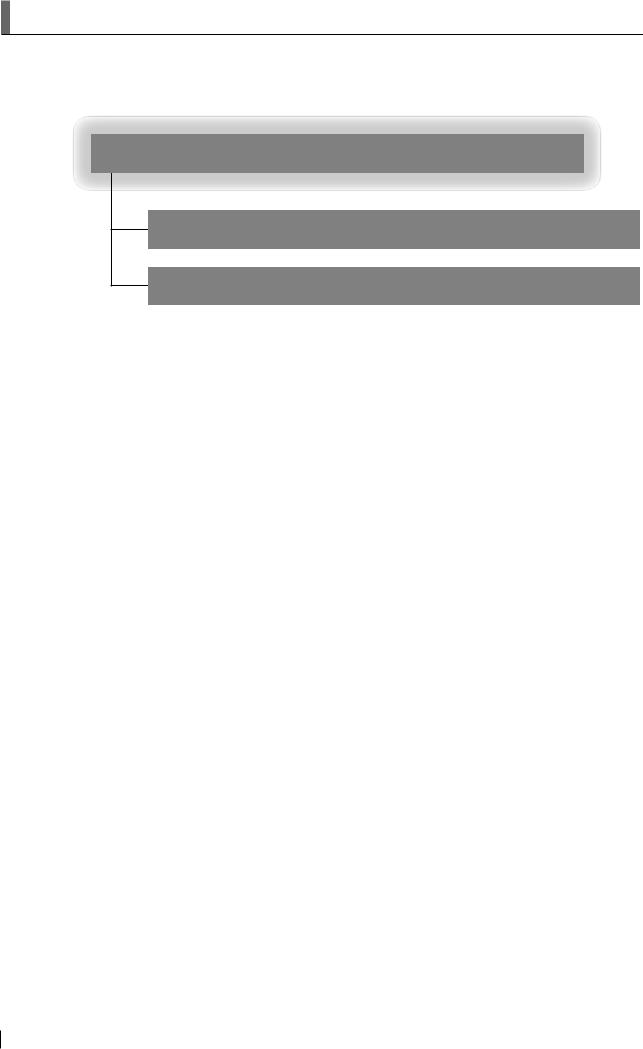
DRYPIX Smart Manuals
DRYPIX Smart Reference Guide
DRYPIX Smart Quality Control Function Reference Guide DRYPIX Smart Quality Control for Mammography Reference Guide
iv DRYPIX Smart Reference Guide 897N102437G
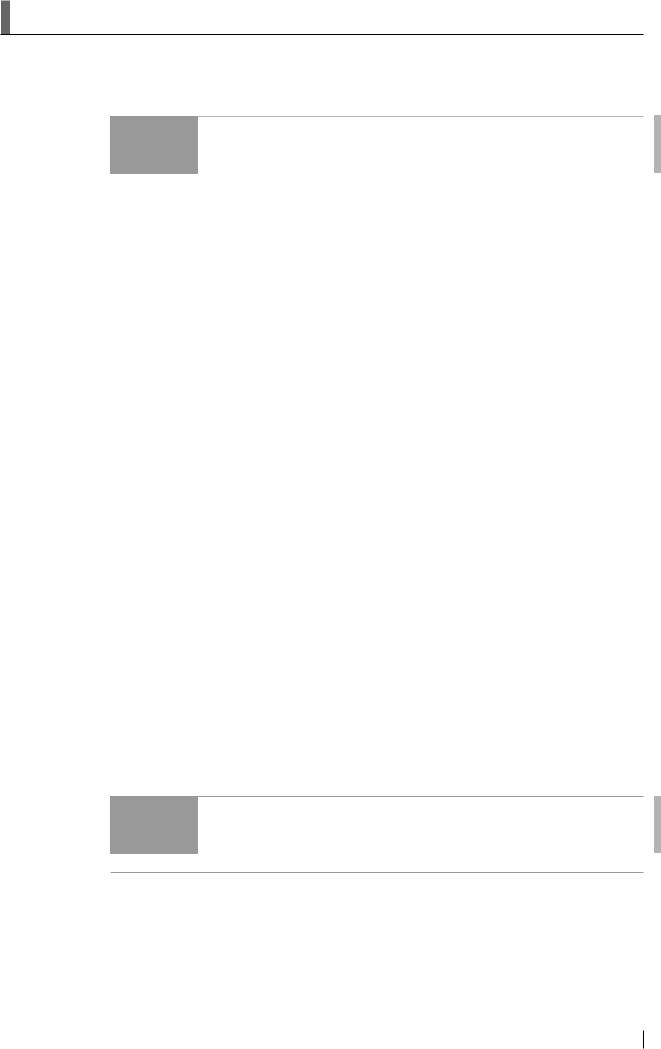
Contents at a Glance
|
For Safe Operation |
Chapter |
This chapter presents Warnings and Cautions we wish you to observe for the |
|
|
1 safe operation of this equipment. |
|
|
2 |
Product Overview |
|
|
Chapter |
This chapter presents overview and major features of this equipment. |
|
||
|
|
|||
|
|
|
|
|
|
|
|
|
|
|
|
|
|
|
|
3 |
Basic Operation |
|
|
Chapter |
This chapter describes routine operation procedures, including how to start up/ |
|
||
shut down this equipment and also how to replace a film pack. |
|
|||
|
|
|||
|
|
|
|
|
|
4 |
Utility |
|
|
Chapter |
This chapter describes the film density calibration, date and time setting as well |
|
||
as other functions. |
|
|||
|
|
|||
|
|
|
|
|
|
5 |
Troubleshooting |
|
|
Chapter |
This chapter explains how to troubleshoot an error. |
|
||
|
|
|||
|
|
|
|
|
|
|
|
|
|
|
|
|
|
|
|
6 |
Care and Maintenance |
|
|
Chapter |
This chapter describes daily care and maintenance we wish you to perform so |
|
||
that you can use the equipment optimally. |
|
|||
|
|
|||
|
|
|
|
|
Appendix |
Appendix A Specifications |
|
||
This chapter presents major specifications of this equipment. |
|
|||
Maintenance and Inspection
DRYPIX Smart Reference Guide 897N102437G v
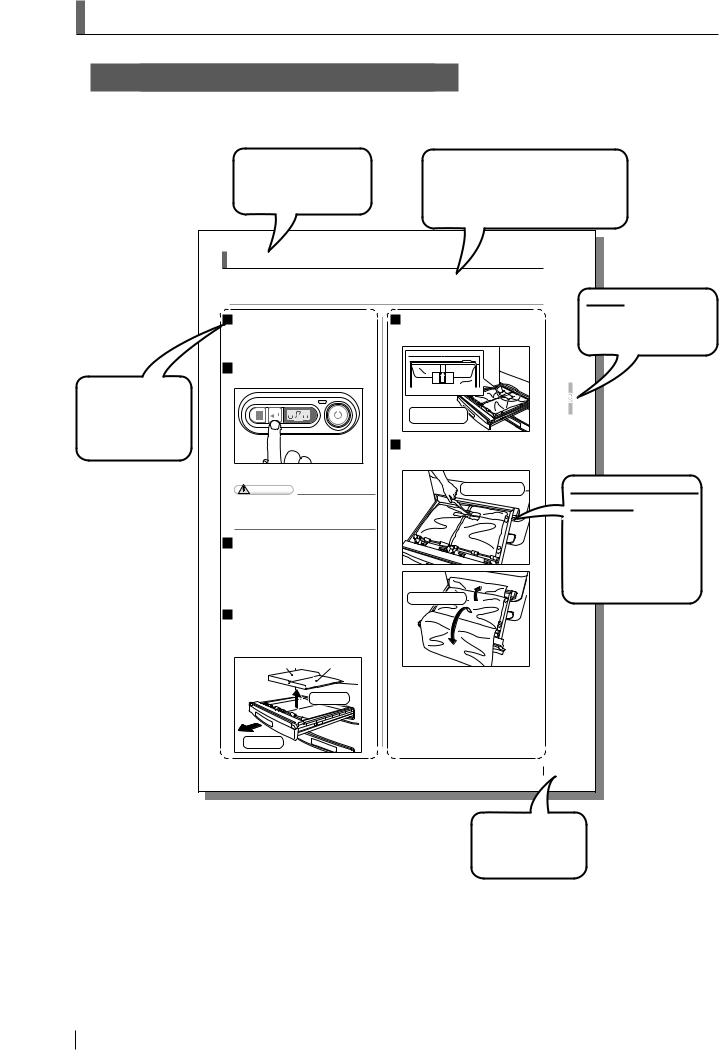
How to Read This Manual
Basic page configuration
Please have a good grasp of the basic page configuration of this Manual, as illustrated below, for you to use it more efficiently.
Section title
Shows the title of an operation procedure described in the section.
Lead
Describes information we wish you to know in advance of your operating the system or information that may help you to operate it.
Operation procedure
Describes an operation procedure according to sequential numbers.
3.2 Replacing the Film |
|
|
When it is printed with the film in the film tray set to “0”, “EP1” (Film Tray 1) or “EP2” (Film Tray 2) is |
|
|
displayed in the Display panel. Prepare Fuji Medical Dry Laser Image Film “DI-HL” or “DI-ML”, pull out |
Index |
|
the film tray, and replace the film pack. |
||
|
1 When the film in the film tray runs out |
5 |
Make sure that the arrow mark on the new |
A caption that facilitates |
||
you to open a desired |
|||||
during the film feeding, the film being fed is |
|
film pack points to the back side of the film |
|||
automatically output and “EP1” or “EP2” is |
|
tray. |
[Chapter] quickly. |
||
displayed in the Display panel. |
|
|
|||
Press the Enter button and unlock the film |
|
|
|
||
tray lock. |
|
|
|
|
|
|
|
|
Film pack side |
3 |
|
|
|
|
|
||
|
|
|
Check the arrow |
|
|
|
|
|
mark direction. |
Basic |
|
|
|
|
pack (2.), as illustrated. |
||
|
|
6 |
Operation |
||
|
|
Raise one end of the film pack to tear off |
|
||
|
|
|
the label (1.), and open both ends of the film |
|
|
“oPn” appears on the Display panel. |
|
|
|
||
CAUTIONS |
|
|
1. Tear off the |
Illustrated operation |
|
after it has been unlocked. Otherwise, a |
|
|
procedure |
||
Be sure to pull the film tray out only |
|
|
|
||
system malfunction will result. |
|
|
Operation steps are |
||
3 When an error occurs during film feeding, |
|
|
presented in the illustration |
||
|
|
following specified order. |
|||
first the film being fed is automatically |
|
|
|||
output, and then the error code appears on |
|
|
Multiple sub-steps that |
||
|
|
|
|||
the Display panel. |
|
|
|
consist of an operation step |
|
When the stand-by Switch, Enter Button or Utility |
|
|
|||
Button is pressed to stop the alarm and clear the |
|
2. Open both ends. |
is numbered, 1., 2. ..... |
||
|
|
||||
error, “EP1” or “EP2” appears on the Display panel. |
|
|
|||
4 Pull the film tray out carefully (1.), and |
|
|
|
||
remove the protective material together |
|
|
|
||
with the film cushioning cardboard (2.). |
|
|
|
||
Discard the removed protective material and film |
|
|
|
||
cushioning cardboard. |
|
|
|
|
|
Film cushioning |
Protective material |
|
|
|
|
cardboard |
|
|
|
||
|
|
|
|
||
|
2. Remove. |
|
|
|
|
1. Pull out. |
|
|
|
|
|
DRYPIX Smart Reference Guide 897N102437G 3-3
Page number
Displayed in conjunction with the chapter number.
vi DRYPIX Smart Reference Guide 897N102437G

Marks
Information items to be observed when you are operating this system and the supplementary remarks are described in this manual with the respective marks.
For the safe system operation, be sure to observe Warning/Caution.
 WARNING
WARNING
 CAUTIONS
CAUTIONS
 HINT
HINT
Indicates hazardous situations that may lead to serious injury or even death if the precaution is not or could not be followed.
Indicates hazardous situations that may lead to mild or moderate injury or physical damages if the caution is not or cannot be followed.
Indicates information that should be noted.
Indicates information that may be helpful.
Shows a more detailed operation method or an item that describes additional information.
Expressions
Messages appear on the display panel as shown below.
● A message displayed on the display panel (sample)
----------------------------- “U-1”
DRYPIX Smart Reference Guide 897N102437G vii

Contents
Introduction iii DRYPIX Smart Manuals iv Contents at a Glance v How to Read This Manual vi
Chapter 1 For Safe Operation
1.1 Precautions Before Operating This Equipment 1-1
1.1.1 Precautions to be Observed When Using the Electric Medical Equipment 1-2
1.2 Safety 1-3
1.3 Electromagnetic Compatibility (EMC) 1-5
1.4 Handling and Storing Cautions for films for the Fuji Dry Imager 1-9
1.5 Locations of labels and signs 1-10
1.5.1 Locations 1-10 1.5.2 Safety and Other Signs 1-13
1.6 Equipment Installation Space 1-14
1.6.1 Installation Space 1-14 1.6.2 Space Required for Maintenance Work 1-14
1.7 Precautions on DRYPIX Smart Operations 1-15
1.7.1 Precautions for Use 1-15 1.7.2 Precautions When Outputting Film Prints 1-16
Chapter 2 Product Overview
2.1 Overview of the DRYPIX Smart 2-1 2.2 Features of the DRYPIX Smart 2-3
2.3 Units Names and the Functions 2-4
2.3.1 DRYPIX Smart Main Unit 2-4 2.3.2 Operation Panel 2-6
Chapter 3 Basic Operation
3.1 Starting / Shutting Down the Equipment 3-1
3.1.1 Starting the Equipment 3-1 3.1.2 Shutting Down the Equipment 3-2
3.2 Replacing the Film Pack 3-3
3.3 Replacing Film Tray 3-6
Chapter 4 Utility
4.1 Utility List 4-1
4.2 Starting Up the Utility 4-2
4.3 Quitting the Utility 4-3 4.4 Automatically Calibrating the Film Density 4-4 4.5 Outputting a QC Test Pattern 4-5 4.6 Resetting the Remaining Film Counter 4-6 4.7 Setting the Sensitive Material Correction Parameter 4-7 4.8 Setting the Date and Time 4-9
viii DRYPIX Smart Reference Guide 897N102437G

4.9 Outputting the SMPTE pattern 4-10 4.10 Outputting the Mammography QC Pattern 4-12
Chapter 5 Troubleshooting
5.1 |
In Case a Problem May Arise |
5-1 |
|
5.2 |
The Equipment Cannot be Powered ON |
5-2 |
|
|
5.2.1 |
The Equipment Does Not Start Up Normally |
5-2 |
5.3 |
The Power to the Equipment Does Not Turn OFF |
5-3 |
|
5.4 |
Error Code List |
5-4 |
|
5.5 |
When a Film Jam Occurred |
5-5 |
|
|
5.5.1 |
Film jamming when the error code “221” or “223” is displayed |
5-6 |
|
5.5.2 |
Film jamming when the error code “226” or “227” is displayed |
5-10 |
|
5.5.3 |
Film jamming when the error code “228” is displayed |
5-11 |
|
5.5.4 |
Film jamming when the error code “230” is displayed |
5-12 |
|
5.5.5 |
Film jamming when the error code “232” is displayed |
5-13 |
Chapter 6 Care and Maintenance
6.1 Cleaning the Inside and Surroundings of the Equipment 6-1
6.1.1 Cleaning a film tray 6-2 6.1.2 Cleaning the Air Filter 6-3 6.1.3 Washing the Cleaning Roller (Optional) with Water 6-4 6.1.4 Image Verification 6-6
6.2 Users Checksheet (Care and Maintenance) 6-7 6.3 About Preventive Maintenance 6-8
Appendix A Specifications
A.1 Specifications A-1
A.2 External View and Weight A-2
Maintenance and Inspection
DRYPIX Smart Reference Guide 897N102437G ix

x DRYPIX Smart Reference Guide 897N102437G

Chapter 1 For Safe Operation
1.1Precautions Before Operating This
Equipment
Before using this equipment, please read “Precautions Before Operating This Equipment” carefully so that you can operate it correctly.
Whenever you operate this equipment, be sure to observe those precautions. Failure to do so may cause you to subject to injuries or property damage to occur.
 WARNING
WARNING
Do not connect any unspecified device.
This system is classified as a medical device under EC Directive 93/42/EEC.
This equipment has been designed on the assumption that the patient would not come into direct contact with it or for operation by appropriately trained operator. The operator of this equipment must comprehend the contents shown in the labels or on the monitor.
Process waste correctly, as stipulated by local law or any regulations that apply. When discarding the DRYPIX Smart that incorporates the lithium battery, be sure to contact a licensed waste disposal contractor because it cannot be disposed of as a general waste.
Not doing so may cause environmental pollution.
To install or relocate the equipment, request it to a designated service supplier.
Cautions on Network
After connecting this system to the network with other systems, confirm that the other systems are not affected. If they are affected, take countermeasures such as network separation.
Precautions on External Network Connection
When a setting of the network to which the equipment is connected has been changed, check that the change does not affect the system operation and take measures if necessary.
The setting change may include the following:
-Change of connection destination
-Addition of devices
-Removal of devices
-Update of devices
-Upgrade of devices
1
Operation Safe For
DRYPIX Smart Reference Guide 897N102437G 1-1

1.1.1Precautions to be Observed When Using the Electric
Medical Equipment
•Do not remodel the equipment.
•In an emergency, disconnect the power plug or the inlet.
Ensure sufficient space around the power plug or the inlet.
•An additional MULTIPLE SOCKET-OUTLET or extension cord shall not be connected to this
1device.
•If the network is shut down due to a network device failure or any other cause, image data is no longer transferred to this device.
Operation Safe For
1-2 DRYPIX Smart Reference Guide 897N102437G

1.2 Safety
Before using the DRYPIX Smart, read this section thoroughly to ensure that you use the product properly.
Laser Handling Precautions
This equipment is a Class 1 Laser Product (IEC 60825-1/EN 60825-1).
This device contains an embedded laser with the following specification:
Class |
: 3B |
Medium |
: Semiconductor laser |
Wavelength |
: 659nm (TYP) |
Maximum output - Specification of Laser Diode |
: 130mW (CW) |
Maximum output - Fault Condition |
: 400mW (CW) |
Beam emittance |
: 20° |
 WARNING
WARNING
To prevent the user from being exposed to laser beams, always observe the following precautions.
●Never remove any covers other than the front cover, right-side cover and bottom right-side cover of the equipment.
●When opening covers for coping with film jams, strictly observe procedures set forth in this manual. Never perform any other procedures.
●Always contact Fujifilm service personnel immediately if a malfunction is suspected in the equipment.
 CAUTIONS
CAUTIONS
Use of controls or adjustment or performance of procedures other than those specified herein may result in hazardous radiation exposure.
Electric Shock Warnings
 WARNING
WARNING
The power supply to the DRYPIX Smart is AC 100/110/120V in North America and AC 200/220/230/240V in other countries.
To avoid electric shocks, users should always take the following precautions:
●Only allow a trained operator to use the printer.
●Install the printer in a location where it will not be exposed to water.
●Check that the printer is securely earthed.
●Check that all of the cords and cables are completely and securely connected.
●When using the equipment within the environment where the patient may get into touch with it, optionally connect additional protective earth conductor.
●When using the equipment within the environment where the patient may get into touch with it, the user must not touch the equipment’s exterior, such as covers and metal sections, and the patient at the same time. In addition, take care that the patient does not touch the equipment.
●To avoid risk of electric shock, this equipment must only be connected to a supply mains with protective earth.
1
Operation Safe For
DRYPIX Smart Reference Guide 897N102437G 1-3

1
Operation Safe For
 WARNING
WARNING
Never remove the printer cover.
The printer contains high-voltage components that could cause an electric shock.
Ventilation precautions
 CAUTIONS
CAUTIONS
Be sure to install this equipment in a well-ventilated environment.
Good ventilation must be ensured (at least 54m3/hour for one unit).
Precaution about High Temperature
 CAUTIONS
CAUTIONS
Be careful with units where High-temperature Caution Labels are affixed as those units may be hot during operation.
Declaration of Conformity
This equipment is in conformance with the following standards:
North America
●UL 60601-1
Other countries
●IEC 60601-1/EN60601-1
●IEC 60601-1-2/IEC 60601-1-2
Classification
1)According to the type of protection against electric shock CLASS 1 EQUIPMENT
2)According to the degree of protection against electric shock NO APPLIED PART
3)Protection against harmful ingress of water or particulate matter IP00
4)According to the degree of safety of application in the presence of a flammable anesthetics mixture with air or with oxygen or nitrous oxide.
Equipment not suitable for use in the presence of a flammable anesthetics mixture with air or with oxygen or nitrous oxide.
5)According to the mode of operation CONTINUOUS OPERATION
1-4 DRYPIX Smart Reference Guide 897N102437G

1.3 Electromagnetic Compatibility (EMC)
This equipment has been tested and found to comply with the limits for medical devices to the IEC60601-1-2+A1 (North America), IEC60601-1-2+A1 (EN60601-1-2+A1), IEC60601-1-2, Medical Device Directive 93/42/EEC (other than North America).
These limits are designed to provide reasonable protection against harmful interference in a typical medical installation.
This equipment generates, uses and can radiate radio frequency energy and, if not installed and used in accordance with the instructions, may cause harmful interference to other devices in the vicinity.
However, there is no guarantee that interference will not occur in a particular installation.
If this equipment does cause harmful interference to other devices, which can be determined by tuning the equipment off and on, the user is encouraged to try to correct the interference by one or more of the followingmeasures:
•Reorient or relocate the receiving device.
•Increase the separation between the equipment.
•Connect the equipment into an outlet on a circuit different from that to which the other device(s) are connected.
Consult the manufacturer or field service technician for help.
Further information for IEC 60601-1-2 (EN60601-1-2)
•Medical electrical equipment needs special precautions regarding EMC and needs to be installed and put into service according to the EMC information provided in the accompanying documents.
•Portable and mobile RF communications equipment should not be used near this medical electrical equipment, as such communications equipment can affect this equipment and the images.
•Information regarding the cable affecting EMC is as follows.
Name |
General Specifiication |
|
|
Network Cable |
Cat5e or more, |
|
UTP type and straight cable |
|
|
•The use of accessories, transducers and cables other than those specified, with the exception of transducers and cables sold by FUJIFILM Corporation as replacement parts for internal components, may result in increased emissions or decreased immunity of the DRYPIX Smart.
•The DRYPIX Smart should not be used adjacent to or stacked with other equipment.
If adjacent or stacked use is necessary, the DRYPIX Smart should be observed to verify normal operation in the configuration in which it will be used.
Guidance and manufacturer’s declaration - electromagnetic emissions
The DRYPIX Smart is intended for use in the electromagnetic environment specified below.
The customer or the user of the DRYPIX Smart should assure that it is used in such an environment.
Emissions test |
Compliance |
Electromagnetic environment - guidance |
|
|
|
|
|
|
|
The DRYPIX Smart uses RF energy only for its internal |
|
RF emissions |
Group 1 |
function. |
|
CISPR 11 |
Therefore, its RF emissions are very low and are not likely |
||
|
|||
|
|
to cause any interference in nearby electronic equipment. |
|
RF emissions |
Class A |
|
|
CISPR 11 |
|
||
|
The DRYPIX Smart is suitable for use in all establishments |
||
Harmonic emissions |
Class A |
||
other than domestic and those directly connected to the |
|||
IEC61000-3-2 |
|||
|
public low-voltage power supply network that supplies |
||
Voltage fluctuations/ |
|
||
|
buildings used for domestic purposes. |
||
flicker emissions |
Complies |
||
|
|||
IEC61000-3-3 |
|
|
1
Operation Safe For
DRYPIX Smart Reference Guide 897N102437G 1-5

1
Operation Safe For
Guidance and manufacturer’s declaration - electromagnetic immunity
The DRYPIX Smart is intended for use in the electromagnetic environment specified below.
The customer or the user of the DRYPIX Smart should assure that it is used in such an environment.
Immunity test |
IEC 60601 test level |
Compliance level |
Electromagnetic environment - |
|
guidance |
||||
|
|
|
||
|
|
|
|
|
|
|
±2kV contact |
Floors should be wood, concrete or |
|
Electrostatic |
|
±4kV contact |
||
discharge |
±6kV contact |
±6kV contact |
ceramic tile. If floors are covered with |
|
(ESD) |
±8kV air |
±2kV air |
synthetic material, the relative humidity |
|
IEC61000-4-2 |
|
±4kV air |
should be at least 30%. |
|
|
|
±8kV air |
|
|
Electrical fast |
±2kV for power supply |
±2kV for power supply |
Mains power quality should be that |
|
lines |
lines |
|||
transient/burst |
of a typical commercial or hospital |
|||
±1kV for input/output |
±1kV for input/output |
|||
IEC61000-4-4 |
environment. |
|||
lines |
lines |
|||
|
|
|||
Surge |
±1kV differential mode |
±1kV differential mode |
Mains power quality should be that |
|
of a typical commercial or hospital |
||||
IEC61000-4-5 |
±2kV common mode |
±2kV common mode |
||
environment. |
||||
|
|
|
||
|
(>95%<5% UTdip in UT) |
(>95%<5% UTdip in UT) |
Mains power quality should be that |
|
Voltage dips, short |
for 0.5 cycle |
for 0.5 cycle |
||
40% UT |
40% UT |
of a typical commercial or hospital |
||
interruptions and |
(60% dip in UT) |
(60% dip in UT) |
environment. If the user of the DRYPIX |
|
voltage variations on |
for 5 cycles |
for 5 cycles |
Smart requires continued operation |
|
power supply input |
70% UT |
70% UT |
during power mains interruptions, it is |
|
lines |
(30% dip in UT) |
(30% dip in UT) |
recommended that the DRYPIX Smart |
|
IEC61000-4-11 |
for 25 cycles |
for 25 cycles |
be powered from an uninterruptible |
|
|
<5% UT |
<5% UT |
power supply or a battery. |
|
|
(>95% dip in UT) |
(>95% dip in UT) |
|
|
|
for 5 s |
for 5 s |
|
|
Power frequency |
|
|
Power frequency magnetic fields should |
|
|
|
be at levels characteristic of a typical |
||
(50/60Hz) magnetic |
3 A/m |
3 A/m |
||
location in a typical commercial or |
||||
fieldIEC61000-4-8 |
|
|
||
|
|
hospital environment. |
||
|
|
|
NOTE: UT is the a.c. mains voltage prior to application of the test level.
1-6 DRYPIX Smart Reference Guide 897N102437G
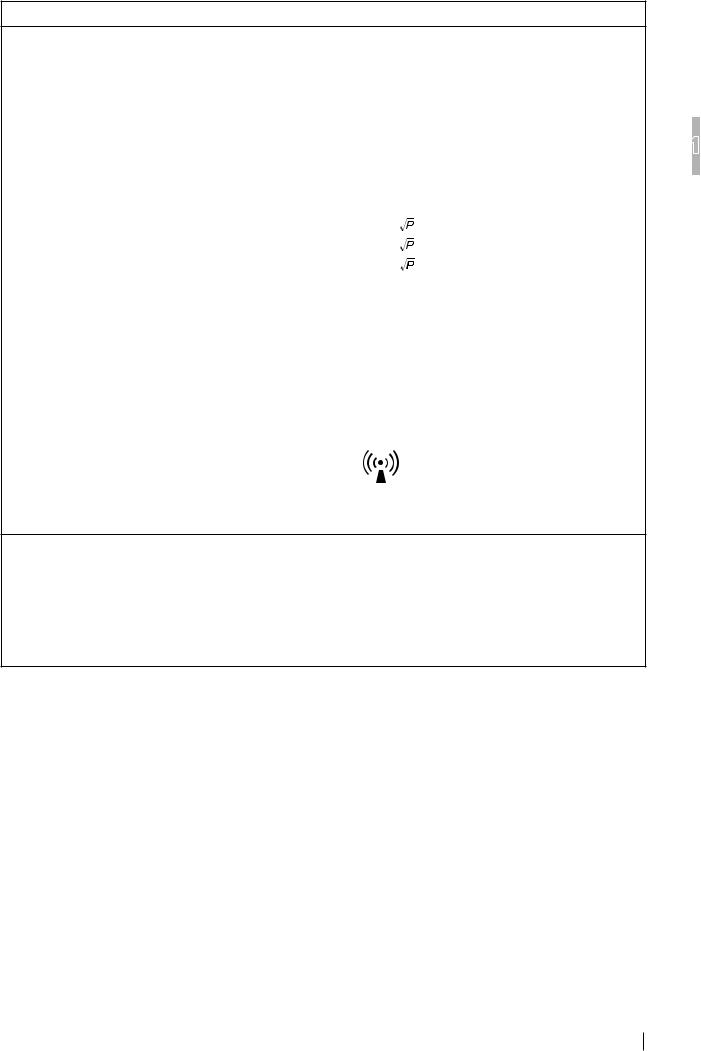
Guidance and manufacturer’s declaration - electromagnetic immunity
The DRYPIX Smart is intended for use in the electromagnetic environment specified below.
The customer or the user of the DRYPIX Smart should assure that it is used in such an environment.
Immunity test |
IEC 60601 test level |
Compliance level |
Electromagnetic environment - guidance |
|
|
|
|
|
|
Conducted RF |
3 Vrms |
3 Vrms |
Portable and mobile RF communications |
|
IEC61000-4-6 |
150 kHz to 80 MHz |
|
equipment should be used no closer to any part |
|
|
|
|
of the DRYPIX Smart, including cables, than the |
|
|
|
|
recommended separation distance calculated from |
|
|
|
|
the equation applicable to the frequency of the |
|
|
|
|
transmitter. |
|
Radiated RF |
3 V/m |
3 V/m |
Recommended separation distance |
|
IEC61000-4-3 |
80 MHz to 2.5 GHz |
|
d = 1.2 |
|
|
|
|
|
|
|
|
|
d = 1.2 |
80 MHz to 800 MHz |
|
|
|
d = 2.3 |
800 MHz to 2.5 GHz |
|
|
|
where P is the maximum output power rating of the |
|
|
|
|
transmitter in watts (W) according to the transmitter |
|
|
|
|
manufacturer and d is the recommended separation |
|
|
|
|
distance in metres (m). |
|
|
|
|
Field strengths from fixed RF transmitters, as |
|
|
|
|
determined by an electromagnetic site survey,a |
|
|
|
|
should be less than the compliance level in each |
|
|
|
|
frequency range.b Interference may occur in the |
|
|
|
|
vicinity of equipment marked with the following |
|
|
|
|
symbol: |
|
|
|
|
|
|
NOTE 1: At 80 MHz and 800 MHz, the higher frequency range applies.
NOTE 2: These guidelines may not apply in all situations. Electromagnetic propagation is affected by absorption and reflection from structures, objects and people.
aField strength from fixed transmitters, such as base stations for radio (cellular/cordless) telephones and land mobile radios, amateur radio, AM and FM radio broadcast and TV broadcast cannot be predicted theoretically with accuracy. To assess the electromagnetic environment due to fixed RF transmitters, an electromagnetic site survey should be considered. If the measured field strength in the location in which the DRYPIX Smart is used exceeds the applicable RF compliance, the DRYPIX Smart should be observed to verify normal operation. If abnormal performance is observed, additional measures may be necessary, such as reorienting or relocating the DRYPIX Smart.
b Over the frequency range 150 kHz to 80 MHz, field strength should be less than 3 V/m.
1
Operation Safe For
DRYPIX Smart Reference Guide 897N102437G 1-7

1
Operation Safe For
Recommended separation distances between
Portable and mobile RF communications equipment and the DRYPIX Smart
The DRYPIX Smart is intended for use in the electromagnetic environment in which radiated RF disturbances are controlled.
The customer or the user of the DRYPIX Smart can help prevent electromagnetic interference by maintaining a minimum distance between portable and mobile RF communications equipment (transmitters) and the DRYPIX Smart as recommended below, according to the maximum output power of the communications equipment.
Rated maximum output |
Separation distance according to frequency of transmitter |
||
|
m |
|
|
power of transmitter |
|
|
|
|
|
|
|
W |
150 kHz to 80 MHz |
80 MHz to 800 MHz |
800 MHz to 2.5 GHz |
|
d = 1.2 |
d = 1.2 |
d = 2.3 |
0.01 |
0.12 |
0.12 |
0.23 |
0.1 |
0.38 |
0.38 |
0.73 |
1 |
1.2 |
1.2 |
2.3 |
10 |
3.8 |
3.8 |
7.3 |
100 |
12 |
12 |
23 |
For transmitters rated at a maximum output power not listed above, the recommended separation distance d in metres
(m) can be estimated using the equation applicable to the frequency of the transmitter, where P is the maximum output power rating of the transmitter in watts (W) according to the transmitter manufacturer.
NOTE 1: At 80 MHz and 800 MHz, the separation distance for the higher frequency range applies. NOTE 2: These guidelines may not apply in all situations.
Electromagnetic propagation is affected by absorption and reflection from structures, objects and people.
1-8 DRYPIX Smart Reference Guide 897N102437G

1.4Handling and Storing Cautions for films for the Fuji Dry Imager
Please be aware of the following cautions for handling and storing of the film.
Precautions for storing or handling unused films
1Use only the “Fuji Medical Dry Laser Image Film DI-HL” or “Fuji Medical Dry Laser Image Film
DI-ML” that is compatible with this equipment. If a film other than DI-HL or DI-HM is used, a malfunction may be caused to the equipment.
2Be sure to store unused films contained in the film pack in a cool, dry and dark place of low temperature and low humidity (temperature: 25°C or lower), avoiding radioactivity and reactive gases, same as for the conventional wet-type film.
3The DI-HL films are light-sensitive. Do not open a film pack before it is loaded properly in the equipment.
4Do not touch unused films with bare hands, otherwise adverse effects can appear on recorded images.
5Do not take unused films out of the film pack that has once been loaded into the equipment and opened or add films to the film pack loaded, which will result in misoperation or failure of the equipment.
6The film pack contains a protective sheet, in addition to the specified number of recording films. This protective sheet will remain in the film pack even after those recording films have been printed and it cannot be used for image recording. Because the protective sheet is a film, discard it appropriately together with other used films.
Precautions for storing or handling recorded films
1Store recorded films in a cool, dry and dark place of low temperature and low humidity. The higher the temperature and humidity, the more the density of recorded images will change sharply. Longterm storage at high temperature, high humidity and/or daylight conditions, such as in a car or room during summer, may cause discoloration. Using films in the slide projector or overhead projector will also cause discoloration.
2For the long-term storage performance of recorded films, we assume based on the result of the acceleration test that it will be over 30 years at the storage temperature of 25ºC and over 25 years at 30ºC, until the portion on an image of density (D) = 1.2 at time of output to change 10%
(ΔD=0.12).
3After an image has been recorded, the film immediately after it was ejected from the machine is still in the process of image development and the room illumination or light emanating from the viewing boxwill cause slight changes in the optical density. Due to such optical effect, traces
of overlapped films or transferred images can be visually recognized temporarily, which will disappear when those films are left under the normal light condition.
4Note that lucid surfaces of recorded films can be lost or traces of contact with any chemicals that contain water, alcohol, developer, etc., and with other objects that contain a large amount of salt may appear on images, if they are handled under high-humidity environment or due to such
undesirable contacts.
5Do not store films with its image recording faces attached directly for preventing them from sticking to each other.
1
Operation Safe For
DRYPIX Smart Reference Guide 897N102437G 1-9
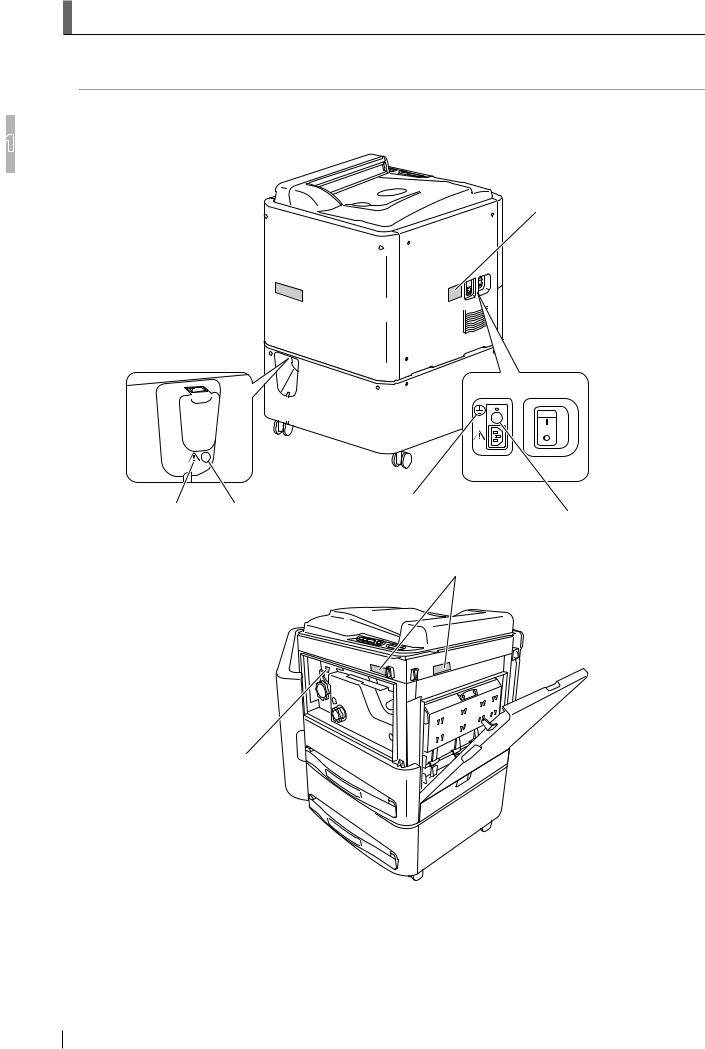
1
Operation Safe For
1.5 Locations of labels and signs
Locations of labels and signs affixed to the DRYPIX Smart, and the relevant safety signs are shown below.
1.5.1Locations
Rating Label
Class 3B Panel Label #1 


|
|
|
|
|
|
|
|
|
|
|
|
|
|
|
|
|
|
|
|
|
|
|
|
|
|
|
|
|
|
|
|
|
|
|
|
|
|
|
|
|
|
|
|
|
|
|
|
|
|
|
|
|
|
|
|
|
|
|
|
|
|
|
|
|
|
|
|
|
|
|
|
|
|
|
|
|
|
|
|
|
|
|
|
Caution Label |
|
Caution Label |
Additional |
|
|
|
|||||
|
protective |
Caution Label |
|||||||||
|
|
|
|
(other than North America |
|||||||
|
|
|
|
earth mark |
|
|
|
||||
HHS Certification and
Identification Label


 Power
Power
Caution Label
(other than North America
Class 3B Panel Label #2
High-temperature
Caution Label
1-10 DRYPIX Smart Reference Guide 897N102437G
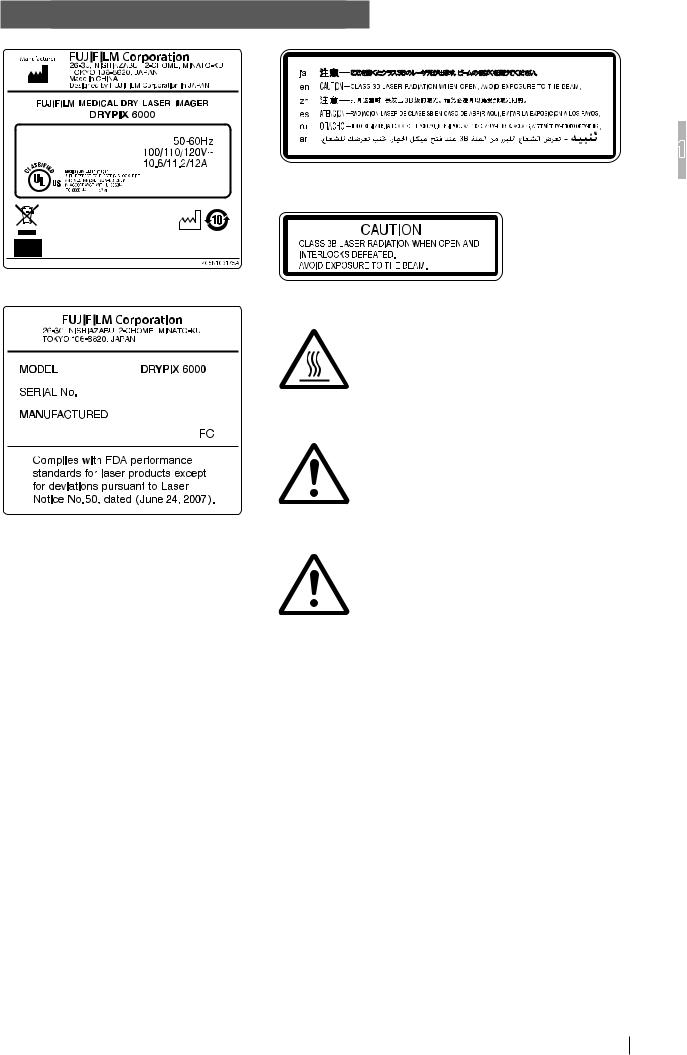
North America
Rating Label
Be aware that the temperature may be high in the area where the following label is affixed.
High-temperature Caution Label
Be sure to use the power cord our official dealer or local presentative provided. If an inappropriate cord is used, it may generate heat or fire.
HHS Certification and Identification Label
Do not connect a telephone wire to the LAN connector. Only UTP-type straight LAN cables of Category 5e or higher are appropriate for connection to this connector.
connector)
1
Operation Safe For
DRYPIX Smart Reference Guide 897N102437G 1-11
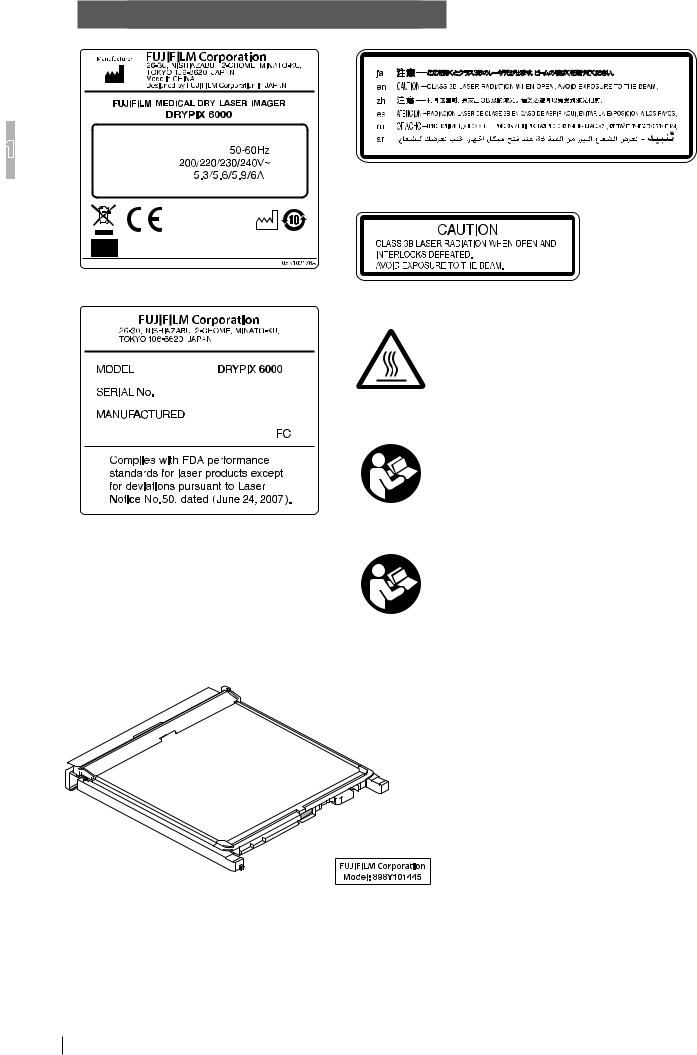
Other countries
1
Operation Safe For
Rating Label
HHS Certification and Identification Label
Class 3B Panel Label #1
Labels #2
Be aware that the temperature may be high in the area where the following label is affixed.
High-temperature Caution Label
Be sure to use the power cord our official dealer or local presentative provided. If an inappropriate cord is used, it may generate heat or fire.
Caution Label (Inlet)
Do not connect a telephone wire to the LAN connector. Only UTP-type straight LAN cables of Category 5e or higher are appropriate for connection to this connector.
Caution Label (LAN connector)
Additional Option Tray
 Identification Label
Identification Label
1-12 DRYPIX Smart Reference Guide 897N102437G

1.5.2 Safety and Other Signs
The following safety signs are used in the DRYPIX Smart labels or on its body.
Sign |
Description |
|
|
This symbol indicates compliance of the equipment with Directive 93/42/EEC.
Refer to operation manual
Attention, consult ACCOMPANYING DOCUMENTS.
High-temperature caution
Power-OFF
Power-ON
Protective grounding (to the earth)
Alternating current
This symbol indicates that this product is not to be disposed of with your household waste, according to the WEEE Directive (2002/96/EC) and your national law. This product should be handed over to a designated collection point.
Improper handling of this type of waste could have a possible negative impact on the environment and human health due to potentially hazardous substances that are generally associated with EEE.
At the same time, your cooperation in the correct disposal of this product will contribute to the effective usage of natural resources.
For more information about waste, please contact FUJIFILM dealers.
Year of manufacture
Environmentally Friendly Use Period (EFUP)
Stand-by switch
Enter button
Utility button
Serial number
Manufacture
1
Operation Safe For
DRYPIX Smart Reference Guide 897N102437G 1-13
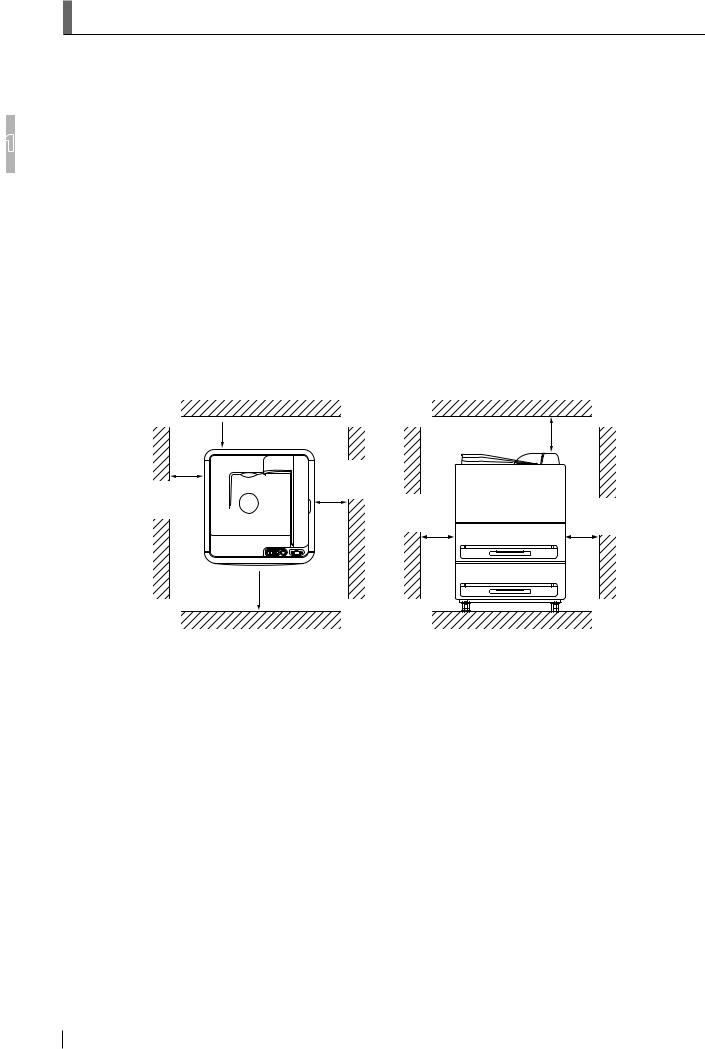
1
Operation Safe For
1.6Equipment Installation Space
1.6.1Installation Space
n When Not Fixed with Fixtures
Front : More than 800 mm (31.5 in.)
Rear : More than 100 mm (3.9 in.)
Left : More than 50 mm (1.9 in.)
Right : More than 200 mm (7.87 in.)
n When Fixed with Fixtures
Front : More than 800 mm (31.5 in.)
Rear : More than 100 mm (3.9 in.)
Left : More than 250 mm (9.8 in.)
Right : More than 250 mm (9.8 in.)
1.6.2Space Required for Maintenance Work
Left : More than 800 mm (31.5 in.)
 Rear : More
Rear : More
than 600 mm (23.6 in.)
Right : More than 800 mm (31.5 in.)
Left : More than 800 mm (31.5 in.)
 Front : More than 1000 mm (39.3 in.)
Front : More than 1000 mm (39.3 in.)
Top : More than 400 mm (15.7 in.)
Right : More than 800 mm (31.5 in.)
1-14 DRYPIX Smart Reference Guide 897N102437G
